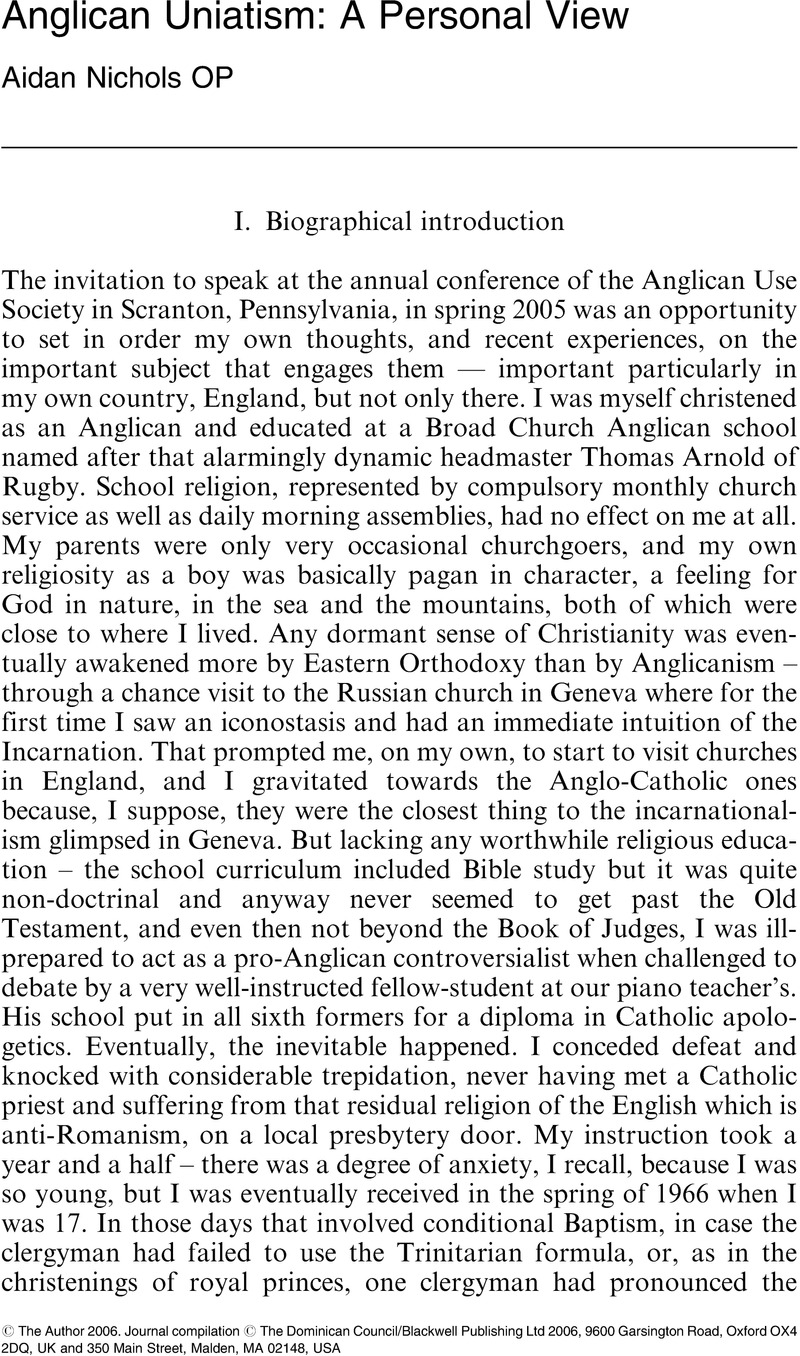No CrossRef data available.
Article contents
Anglican Uniatism: A Personal View
Published online by Cambridge University Press: 01 January 2024
Abstract

- Type
- Original Articles
- Information
- Copyright
- © The Author 2006. Journal compilation © The Dominican Council/Blackwell Publishing Ltd 2006, 9600 Garsington Road, Oxford OX4 2DQ, UK and 350 Main Street, Malden, MA 02148, USA
References
1 Nichols, A. O. P., The Panther and the Hind. A Theological History of Anglicanism(Edinburgh 1993), pp. 177–180Google Scholar.
2 Oddie, W., The Roman Option. Crisis and the Realignment of English-speaking Christianity(London 1997)Google Scholar.
3 Duffy, E., The Stripping of the Altars. Traditional Religion in England, 1400–1580(New Haven and London 1992)Google Scholar; idem., The Voices of Morebath. Reformation and Rebellion in an English Village(New Haven and London 2001)Google Scholar. Through the generosity of the author, I briefly had access to the proofs of the first book when reading the proofs of my own – but the impact Duffy's book would make was of course at that juncture unknown.
4 Haigh, C., English Reformations: Religion, Politics and Society under the Tudors(Oxford 1993)Google Scholar. See also idem. (ed)., The English Reformation Revised(Cambridge 1987)Google Scholar.
5 Scarisbrick, J. J., The Reformation and the English People(London 1984)Google Scholar.
6 E. Duffy, The Stripping of the Altars, op.cit., p. 4.
7 MacCulloch, D., The Later Reformation in England, 1547–1603(Basingstoke 1990; 1992)CrossRefGoogle Scholar; idem., Thomas Cranmer. A Life(New Haven and London 1996)Google Scholar; idem., Tudor Church Militant. Edward VI and the Protestant Reformation(London 1999; 2001)Google Scholar; idem., Boy King: Edward VI and the Protestant Reformation(Berkeley, CA, 2002)Google Scholar.
8 Idem., ‘The Myth of the English Reformation’, Journal of British Studies 30 (1991), pp. 1–19CrossRefGoogle Scholar, and here at p. 2.
9 Ibid., p. 7.
10 Ibid., pp. 7–8.
11 Ibid., p. 9
12 Ibid., p. 10.
13 Ibid., p. 12.
14 Ibid., p. 17.
15 Ibid., p. 19.
16 Gilley, S., ‘The Ecclesiology of the Oxford Movement: a Reconsideration’, Nova I. 1 (1996), pp. 4–9, and here at p. 4Google Scholar.
17 Ibid., p. 5. The evidence is laid out in Gilley's prosopographical study of Newman in relation to his contemporaries, the distinguishing feature of his biography of the Servant of God: thus Gilley, S., Newman and his Age(London 1990)Google Scholar.
18 Idem., ‘The Ecclesiology of the Oxford Movement’, art. cit., p. 5.
19 Ibid., p. 7.
20 Ibid.
21 Ibid., p. 9. This essay is more easily accessible under the same title in Vaiss, P. (ed.), From Oxford to the People(Leominster 1996), pp. 60–75Google Scholar.
22 Clément, O., You are Peter. An Orthodox Theologian's Reflection on the Exercise of the Papal Primacy(Hyde Park, NY, 2000)Google Scholar. I owe this point to Father John Hunwicke.
23 Baker, J. (ed.), Consecrated Women? A. Contribution to the Women Bishops’ Debate(Norwich 2004)Google Scholar.
24 See Williams, R. I., The Book of Divine Worship. A Catholic Critique(Bangor is y Coed, 2004)Google Scholar for details. I disagree with Mr Williams inasmuch as he objects to any use of Cranmerian paraphrases or compositions on principle; I would defend it on the patristic principle of ‘despoiling the Egyptians’.
* An earlier version of this article appeared in Anglican Embers. Quarterly Journal of the Anglican Use Society I.7 (2005), pp. 171–195, and extracts therefrom in New Directions 8.124 (August 2005), p. 17, & 8.125 (September 2005), pp. 13–14.


